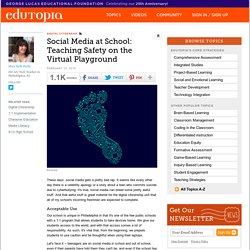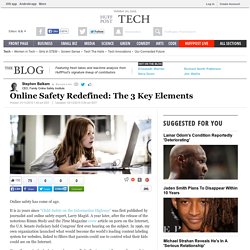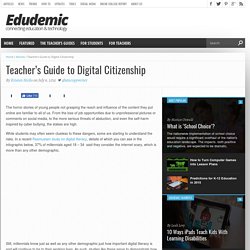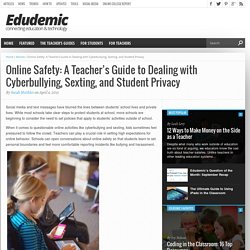

Digital Natives, Yet Strangers to the Web. When Reuben Loewy took up his first teaching gig in 2012, he had a major revelation: The digital revolution has dramatically transformed the way that kids perceive reality.

Perhaps that makes the 55-year-old teacher sound like a dinosaur. What he discovered is, after all, one of the most obvious realities shaping education policy and parenting guides today. But, as Loewy will clarify, his revelation wasn’t simply that technology is overhauling America’s classrooms and redefining childhood and adolescence. Rather, he was hit with the epiphany that efforts in schools to embrace these shifts are, by and large, focusing on the wrong objectives: equipping kids with fancy gadgets and then making sure the students use those gadgets appropriately and effectively. Educational institutions across the board are certainly embracing (or at least acknowledging) the digital revolution, adopting cutting-edge classroom technology and raising awareness about the perils and possibilities of the Internet.
7 Characteristics Of A Digitally Competent Teacher. Copyright Flowchart: Can I Use It? Yes? No? If This… Then… It is the responsibility of all educators to model good digital citizenship for their students.

Especially when it comes to copyright, plagiarism and intellectual property. Digital Tattoo: What's Yours? Connecting Families. 10 Things Your Students Should Know About Their Digital Footprints. Building a digital legacy is an issue I believe doesn’t garner enough attention in our personal and professional lives.

In fact, some of the heaviest users of online tools and social media, are our young students, who are growing up as a generation of visual learners and visual attention seekers. This is in fact the Facebook and YouTube generation, and the reality is that many teens are unconcerned about the dangers of sharing personal information online. A highly respected education advocate, Kevin Honeycutt, once asked me if any of us from our generation (GenX and before), had ever made a mistake in puberty. He then asked if our mistakes are “Googleable.” The reality is that our mistakes from puberty are not “Googleable”. With that in mind, I have developed some important facts and opinions that our students should be completely aware of as they live in their digital world, creating digital footprints along the way. 1.) 3.) 4.) 5.) 6.) 7.) 8.) 9.) 10.)
Social Media at School: Teaching Safety on the Virtual Playground. These days, social media gets a pretty bad rap.

It seems like every other day there is a celebrity apology or a story about a teen who commits suicide due to cyberbullying. It's true, social media can breed some pretty awful stuff. The Digital Tattoo Project. Online Safety Redefined: The 3 Key Elements Online safety has come of age.

It is 21 years since "Child Safety on the Information Highway" was first published by journalist and online safety expert, Larry Magid. A year later, after the release of the notorious Rimm Study and the Time Magazine cover article on porn on the Internet, the U.S. Senate Judiciary held Congress' first ever hearing on the subject. In 1996, my own organization launched what would become the world's leading content labeling system for websites, linked to filters that parents could use to control what their kids could see on the Internet. Since then we've had what one observer called a "technopanic" over online predators, which reached its apotheosis (or nadir) in NBC Dateline's To Catch a Predator.
MediaSmarts. I am a Digital Citizen. Teaching The Concept Of Digital Footprint To Middle School Students. Digital Natives, Yet Strangers to the Web. Teacher's Guide to Digital Citizenship. The horror stories of young people not grasping the reach and influence of the content they put online are familiar to all of us.

From the loss of job opportunities due to unprofessional pictures or comments on social media, to the more serious threats of abduction, and even the self-harm inspired by cyber bullying, the stakes are high. While students may often seem clueless to these dangers, some are starting to understand the risks. In a recent Rasmussen study on digital literacy, details of which you can see in the infographic below, 37% of millennials aged 18 – 34 said they consider the internet scary, which is more than any other demographic. Still, millennials know just as well as any other demographic just how important digital literacy is and will continue to be to their working lives. As such, studies like these serve to demonstrate how crucial teaching digital literacy — particularly at a young age when that digital footprint is still lightly drawn — has become.
Digital Citizenship Resources. Online Safety: A Teacher’s Guide to Dealing with Cyberbullying, Sexting, and Student Privacy. Social media and text messages have blurred the lines between students’ school lives and private lives.

While most schools take clear steps to protect students at school, more schools are beginning to consider the need to set policies that apply to students’ activities outside of school. When it comes to questionable online activities like cyberbullying and sexting, kids sometimes feel pressured to follow the crowd. Teachers can play a crucial role in setting high expectations for online behavior. Schools can open conversations about online safety so that students learn to set personal boundaries and feel more comfortable reporting incidents like bullying and harassment. Image via Flickr by Brad Flickinger.
Privacy.